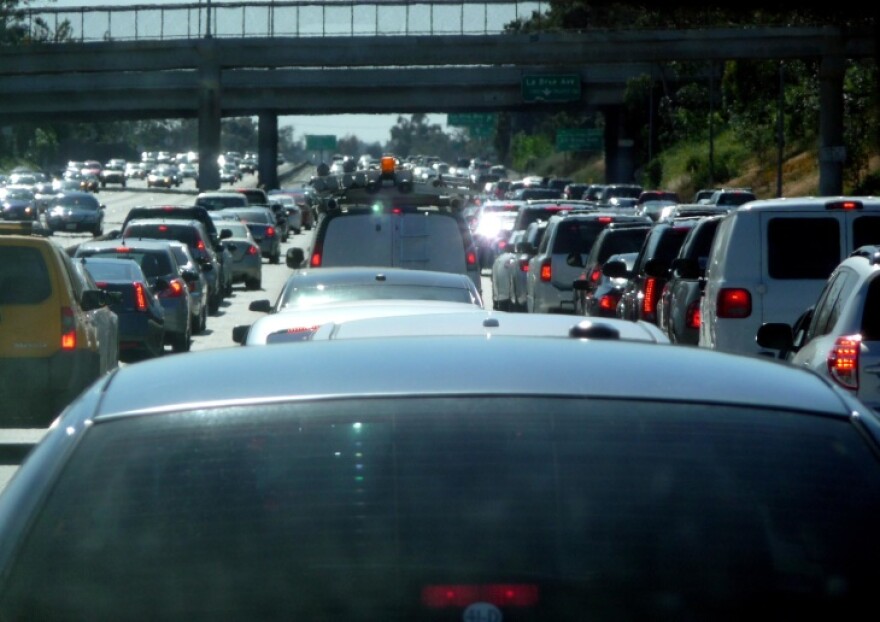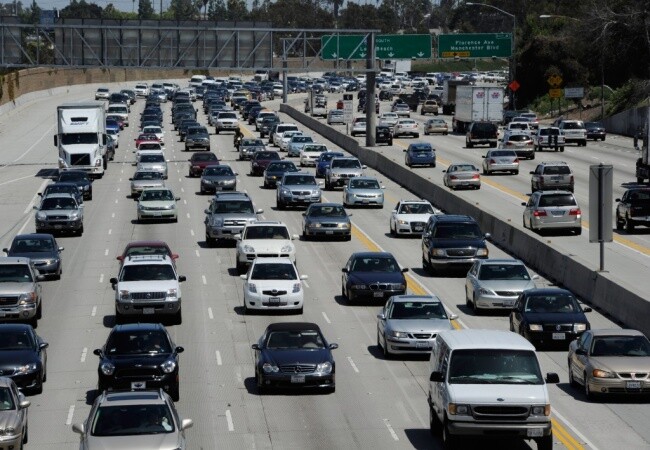Truth matters. Community matters. Your support makes both possible. LAist is one of the few places where news remains independent and free from political and corporate influence. Stand up for truth and for LAist. Make your year-end tax-deductible gift now.
Nothing Can Fix LA Traffic, So Deal With It

THIS STORY IS PART OF HOW TO L.A., OUR ONGOING SERIES OF PRACTICAL GUIDES FOR DAY-TO-DAY LIVING IN LOS ANGELES.
Here's a dirty little secret that politicians, agencies and transportation innovators probably don't want you to know: there is almost nothing they can do to fix traffic in a thriving city like Los Angeles.
This may come as a surprise, if you listen to claims about new train lines, freeway expansions, bike lanes, autonomous vehicles, flying Ubers and underground tunnel systems, which are promoted as ways to alleviate congestion.
But while some of these may indeed bring mobility benefits or quality-of-life improvements, none of them is a cure for traffic.
BUT ELON SOUNDED SO LEGIT
I know. And for those of us who aren't steeped in academic transportation theory, this gridlocked inevitability can seem depressing and/or counterintuitive.
But think about it -- can you name any major city in the world that doesn't have slow traffic?
Congestion persists no matter how awesome a city's transit system is, or how complete its bike network is, or how big the freeways are or how much new technology has advanced.
Transportation planners have been documenting this phenomenon for almost a century.
MORE CAPACITY = MORE TRAFFIC
Oft-cited research from economist Anthony Downs found -- as far back as the 1960s -- that traffic on urban freeways always increases to meet maximum capacity. He also found that adding new roads or lanes doesn't help.
A 2009 study called "The Fundamental Law of Road Congestion" reiterated these findings with modern evidence from U.S. cities.
"When we add highway capacity to a city, we see traffic increase at exactly the same rate," said Matthew Turner, co-author of the paper and a professor of economics at Brown University.

Even in Los Angeles' recent history, we have ample evidence of this road congestion phenomenon: the $1.6 billion expansion of the 405 Freeway's Sepulveda Pass. The project took five years and added another lane in each direction, and yet hasn't moved the needle on peak-hour delays.
In fact, a Los Angeles County Metropolitan Transportation Authority study showed rush-hour travel times actually slowed by a minute on average during the year after completion in 2014, and traffic has only increased since then.
A USC/Metro study found the first phase of the Expo Line light rail from downtown to Culver City also had no effect on traffic on the parallel 10 Freeway or nearby streets. That's despite the fact the rail line attracted healthy ridership of more than 30,000 people a day.
IT'S NOT JUST ABOUT SPACE
The main concept to understand is that traffic isn't just about available space. Space is only one of the two major variables affecting congestion.
The other is demand -- how much people want to drive.
And in busy, crowded places like L.A., demand doesn't stay the same when you increase capacity; it's very dynamic.
Translation: The easier you make it to drive, the more people want to do it.
For instance, you might avoid visiting a good friend often in West L.A. because the traffic there is bad. But if new capacity is added, that makes it easier to drive and you'll visit your friend more often or at times you would have previously avoided.
Or if driving gets easier, you might take a job that's a little further away, decide to shop often or eat out more nights of the week than you used to, commute to work a little later, take an easier main route instead of backroads or stop making the effort to take transit.
"When you add up the millions and millions of people in the L.A. area, the aggregate effect of those individual decisions to venture out onto the roadway means that it's hard for adding a lane or even a couple lanes to really move the needle on traffic during peak hours," said Juan Matute, deputy director of the UCLA Institute of Transportation Studies.

WHAT ABOUT THE AUTONOMOUS CARS / TUNNELS / FLYING TAXIS / NEXT-BIG-THINGS?
The problem all these ideas have in common is that they only address one variable in the traffic equation: capacity.
Autonomous vehicles do have the potential to make traffic flows more efficient, which will free up space on the roads. Routing traffic through the air or underground also adds extra capacity to the system. But they fail to address demand.
"We have a lot of experience with capacity increases," said Turner of Brown University.
"It's not clear that the capacity expansion that we get from these is going to be different than the capacity expansion that we get from adding lanes," which his research and that of others show does not reduce congestion because more space makes driving easier and thus increases demand.
History also proves that congestion in cities isn't a problem that can be solved with new technology.

"The streetcar was a solution to the problem of congestion of animals and people in the streets, and the automobile was the solution to the problem of streetcars being congested and backed up on the streets," said Brian Taylor, director of the UCLA Institute of Transportation Studies. "So, if there's a constant through this, it's congestion within cities."
While each new development and expansion of capacity bestowed a temporary benefit on drivers, as when the new freeway system was built in Los Angeles, Taylor said the new freedom is always short-lived as travel patterns and demand adjust to the new realities.
"Nature abhors a vacuum and the transportation system abhors extra capacity. So things fill back in," he said.
FOR WHOM THE CAR TOLLS
One of the only research-proven methods that experts agree can reduce congestion is tolls, which attack the demand factor in the traffic equation.
"In the same way as if you made any other thing available for free, then people will use more of it," said Turner, comparing roads to any other commodity that can be priced according to the demand.
A tolling system has proven successful in cities like London, Stockholm and Singapore, where fees are charged to drive in the busiest central parts of town and adjusted up or down based on how crowded the streets are at any given time.
Revenues from the tolls are reinvested in driving alternatives, like improved transit or biking and walking infrastructure.
However, while Los Angeles and nearby counties have put in toll lanes on freeways, the idea of deploying them on a large scale to mitigate congestion remains highly controversial and unpopular.
Taxpayers, after all, already pay for the building and maintenance of roads, and some complain that charging tolls or use fees for roads would unfairly burden the poor.
FINDING ACCEPTANCE
This all leaves us with one last solution: acceptance.
UCLA's Taylor said we should look on the bright side: all this congestion is actually reflecting positive things about our economy and our access to the good things in life.
"Think about places that have no congestion -- Brownsville, Texas, or Salina, Kansas, or Detroit. We don't say, 'It's so great in those places because they don't have any congestion.' Congestion is a problem that arises from all of the activity we have in cities."







